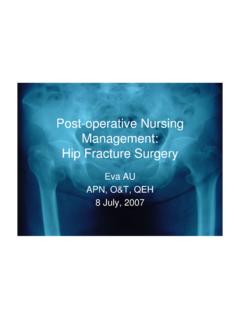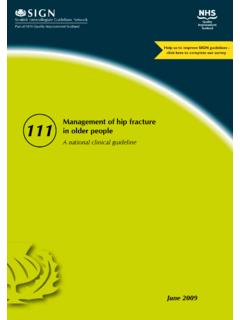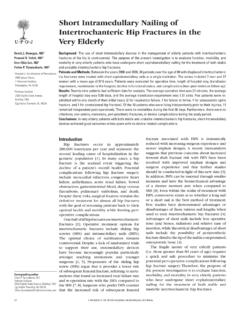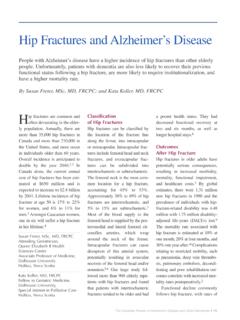Transcription of ACUTE MANAGEMENT AND IMMEDIATE …
1 JUNE 2003 ACUTE MANAGEMENTAND IMMEDIATEREHABILITATION AFTERHIPFRACTUREAMONGST PEOPLE AGED65 YEARS AND OVERBEST PRACTICEEVIDENCE-BASEDGUIDELINEE ndorsed byNZ Orthopaedic AssociationSupported byRoyal Australasian College of Surgeons - New Zealand BranchAustralasian College for Emergency MedicineNew Zealand Nurses OrganisationHospitals Association, Geriatric SocietyBest Practice Evidence-basedGuidelineACUTE MANAGEMENT AND IMMEDIATE rehabilitation after HIP fracture AMONGST PEOPLE AGED 65 YEARS AND OVERJUNE 2003 2003 New Zealand Guidelines Group (NZGG)PO Box 10 665, The Terrace,Wellington, New ZealandPhone: 64-4-471 4180 Facsimile: 64-4-471 4185E-mail: June 2003 Review Date: 2005 ISBN: 0-473-09091-0 STATEMENT OF INTENTC linical guidelines are produced to help health professionals and consumers make decisions about health care in specific clinical circumstances. Research has shown that if properly developed, communicated and implemented, guidelines can improve care.
2 The advice on ACUTE MANAGEMENT and IMMEDIATE rehabilitation after hip fracture amongst people aged 65 years and over given in this guideline is based on epidemiological and other research evidence, supplemented where necessary by the consensus opinion of the expert development team based on their own experience. While the guidelines represent a statement of best practice based on the latest available evidence (at the time of publishing), they are not intended to replace the health professional s judgment in each individual iiiAbout the Guideline vIntroduction ixCHAPTERS1 Non-surgical MANAGEMENT 12 Surgical MANAGEMENT 73 IMMEDIATE rehabilitation 114 Implementation 135 Audit and Performance Indicators 15 APPENDIX 17 Glossary 19 References 23iiiPURPOSEThe purpose of this guideline is to provide an evidence-based summary of the clinical aspects of hip fracture MANAGEMENT and IMMEDIATE rehabilitation amongst people aged 65 years and
3 Over. By following the evidence-based recommendations, most older people suffering hip fracture will be able to access the most effective treatment and return quickly to their previous residence and guideline draws on the best evidence available from New Zealand and international sources, and is designed to inform decisions made by policy makers, funders, clinicians and consumers. It should not be construed as including all appropriate methods of care, or excluding other acceptable treatments. Decisions taken in the MANAGEMENT of any individual in any relevant age group must be determined by the health care team and the person with hip fracture in the light of the clinical problem, and the diagnostic and MANAGEMENT options THE GUIDELINEFOREWORDThe New Zealand Guidelines Group Incorporated (NZGG) is a not-for-profi t organisation established to promote effective health and disability services.
4 Guidelines make a contribution to this aim by sharing the latest international studies and interpreting these in a practical way for adoption in the New Zealand setting. This guideline addresses the best practice for the following aspects of ACUTE MANAGEMENT and IMMEDIATE rehabilitation after hip fracture : pre-hospital care, pre-operative preparation, and post-operative MANAGEMENT surgical MANAGEMENT IMMEDIATE guideline has been developed to inform decisions both about clinical aspects of hip fracture MANAGEMENT , and about resource allocation. It should not be construed as including all appropriate methods of care, or excluding other acceptable DEVELOPMENT PROCESSIn 2001 a multidisciplinary group of professionals and consumers was convened as the hip fracture guideline development team to develop two best practice evidence-based guidelines for people aged 65 years and over: one on the ACUTE MANAGEMENT and IMMEDIATE rehabilitation after hip fracture ; the other on the prevention of hip fracture .
5 Both guidelines are available for download at systematic search was made for published guidelines. Two previous guidelines were identifi ,2 The guideline development team agreed to update and extend the scope of the earlier guidelines as well as adapt them to New Zealand used by the group in preparing the guideline for the ACUTE MANAGEMENT and IMMEDIATE rehabilitation after hip fracture amongst people aged 65 years and over are available on the New Zealand Guidelines Group website at click on Supporting Materials for this GUIDELINE DEVELOPMENT TEAMThe hip fracture guideline development team was commissioned by the New Zealand Guidelines Group and funded by the Ministry of Health to develop a best practice, evidence-based guideline on ACUTE MANAGEMENT and IMMEDIATE rehabilitation after hip fracture amongst people aged 65 years and over. A multidisciplinary group was convened with members representing stakeholder professional groups and consumers.
6 Contributors were:Research and Writing GroupWilliam Gillespie (Convenor)Orthopaedic Surgeon; Dean, Hull York Medical School; (formerly Dean, Dunedin School of Medicine, University of Otago); formerly NZGG Board Member; ChM, FRACS, FRCPEdJohn CampbellProfessor of Geriatric Medicine, University of Otago Medical School; MD, FRACPM elinda GardnerPhysiotherapist, Fall Prevention Research, Northern DHB Support Agency Ltd; Mphty, PhDLesley GillespieTrial Search Co-ordinator for the Cochrane Musculoskeletal Injuries Group, The University of York; Orthopaedic Nursing, Clinical Epidemiology; BSc (Soc Sci), MMedSci (Clin Epi), RGNJan JacksonFractured Neck of Femur Clinical Nurse Specialist, Auckland District Health Board; Diploma in Comprehensive Nursing, Post Graduate Certifi cate in Health ScienceClare RobertsonSenior Research Fellow, Fall Prevention Research, Economic Evaluation, University of Otago Medical School; BSc (Hons), BCom, PhDJean-Claude TheisAssociate Professor of Orthopaedic Surgery, Dunedin School of Medicine; MD, MChOrth, FRCS Ed, FRACSR aymond JonesProject Co-ordinator, Otago District Health Board; Post Graduate Diploma in Health Informatics, Registered Nurse (UK and NZ), English Nursing Board Post Graduate Certifi cate in Orthopaedic NursingConsultation GroupMarion Robinson (Dunedin)Personal experience of hip fractureHeather Thomson (Opotiki)M ori, Consumer AdvocateJim Reid (Dunedin)General medical practiceviDeclaration of Competing InterestsJohn Campbell has received research funding from the Accident Compensation Corporation (ACC).
7 CONSULTATIONA draft of the guideline was widely circulated to over 30 individuals/organisations for peer review. Comments were received from the following: ACC Injury Prevention Division Allan Panting, Nelson Hospital Bruce Twaddle, Orthopaedics Department, Auckland District Health Board David Rankin, General Manager, ACC Healthwise Gail Leach, Executive Director, NZ Society of Physiotherapists Jan Nicholson, Canterbury District Health Board Keith McKea, General Manager Injury Prevention, ACC Lyn Muller, Taranaki Health Mark Flowers, Chief Executive Offi cer, Hawke s Bay District Health Board Orthopaedic Ward, Nelson Hospital Osteoporosis New Zealand Inc Raewyn Osbaldiston, Department of Orthopaedic Surgery, Auckland Hospital Richard Webb, Chief Executive, Canterbury District Health Board Roger Harris, Department of Orthopaedic Surgery, Auckland Hospital Sandy Dawson, Ministry of AND RECOMMENDATION GRADING SYSTEMThe grading system is a two-tier system where the INDIVIDUAL STUDIES are each given a level of evidence from 1 to 4 (refer Appendix for the details)
8 Throughout the guideline, the level of evidence has been included alongside the references. This is formatted as reference[level of evidence].The second step in grading is to consider the WHOLE BODY OF EVIDENCE ie, all the studies relevant to the issue, and decide on a recommendation and grade based on all of the individual OF RECOMMENDATIONSAAt least one meta-analysis, systematic review, or RCT rated 1++, and directly applicable to the target population; orA body of evidence consisting principally of studies rated as 1+, directly applicable to the target population, and demonstrating overall consistency of body of evidence consisting principally of studies rated as 2++, directly applicable to the target population, and demonstrating overall consistency of results; orExtrapolated evidence from studies rated as 1++, or 1+.CA body of evidence consisting principally of studies rated as 2+, directly applicable to the target population, and demonstrating overall consistency of results; orExtrapolated evidence from studies rated as 2++.
9 DEvidence level 3 or 4; orExtrapolated evidence from studies rated as 2+.The grades A to D are a measure of the strength of evidence underlying the recommendations and should not be construed as an indication of the relative importance of the consequences of hip fractures in older people create a signifi cant and increasing burden of illness in the community, and represent for many who suffer them a dramatic decline in physical function .3 Their anxiety is not without cause; 20% of older people who sustain a hip fracture die within a year. In New Zealand, the survivors, two years after the fracture , are more than four times more likely to have limited mobility than people of similar age without a fracture , and more than twice as likely to be functionally New Zealanders of European origin, surveyed in the Auckland region in 1994,5 age-adjusted annual incidence rates were comparable with other societies. Ninety-seven percent of hip fractures occurred in people identifi ed as of European origin, compared with for M ori and for Pacifi c peoples.
10 The crude incidence rate for the population as a whole was women per 100,000 and per 100,000 in men. The chance of sustaining a hip fracture increases with age. Amongst women of European origin, age-specifi c rates ranged from per 100,000 in under 65 year olds to in women aged 95 years and over. Sixty-seven percent of the hip fractures were sustained by those aged 80 years or older. In M ori and Pacifi c Island populations, the difference in rates between men and women were not apparent. Overall crude rates in M ori were per 100,000 for women, and for men; in Pacifi c peoples, the rates were per 100,000 for women, and for men. The size of the difference between M ori and non-M ori is notable because the rate of reporting a fall in the previous 12 months does not show a signifi cant difference (26% and 25%).6 Thus, hip fractures are common and have a large impact. Once an older person has suffered a hip fracture , she or he will require considerable attention from health services.





